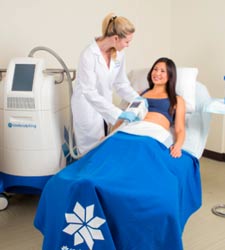Freeze or Melt: What's the Best Way to Kill Fat Cells?

Everyone is born with a certain number of fat cells. That number goes up and down until you reach puberty. After that, the number stays the same. But, as we discover soon enough, the size of fat cells can change. They expand because of diets high in fats, increased calories, and hormones. Expanding fat cells is what causes weight gain.
This is not a revelation, of course.
But that's not where the story ends. For many men and women at or near a healthy weight, it's not about losing extra pounds. They work out and eat right, but they just have a lot of fat cells in areas that tend to be less attractive. And no matter how many miles run or crunches crunched, those bulges remain.
That, in a nutshell, is why nonsurgical fat reduction treatments are becoming among the most popular cosmetic procedures available. The number of treatments performed increased more than 40% in one year, according to a survey from the American Society for Aesthetic Plastic Surgery (ASAPS). Those numbers are increasing even as liposuction remains as popular as ever.
"As one of the first surgeons in Florida to offer the CoolSculpting procedure after it was introduced, I was thrilled to see this number," says Dr. Kent V. Hasen, a body contouring specialist who also performs liposuction at his Naples-Fort Myers practice. "It reinforces my enthusiasm for the treatment and other similar procedures, such as Vanquish Me™. Here in the office, my staff and I have seen firsthand the impressive results that these devices can create without significant downtime."
That lack of downtime is one of the features that separates nonsurgical treatments such as CoolSculpting from liposuction, which of course is a surgical procedure that offers more dramatic fat reduction.
But if nonsurgical fat reduction treatments all have the same goal, what separates one from another? It's all about the temperatures.
CoolSculpting "freezes" fat, and it has become the most popular of the nonsurgical fat reduction procedures. The CoolSculpting technique relies on the fact that fat cells begin to die at temperatures that aren't cold enough to damage the skin or surrounding tissues.
The procedure itself involves using applicators that are designed for the specific treatment area, which then cool the area until the cells begin to die. CoolSculpting can reduce pockets of fat in the abdomen, on the flanks (or "love handles"), the inner and outer thighs, and submental "double chin" fat.
SculpSure® is the first laser fat reduction treatment cleared by the FDA. It uses heat instead of cold temperatures to reduce fat, targeting the abdominal areas and love handles. Applicators zap the fat cells while leaving the skin undamaged.
One advantage of SculpSure is that a treatment session takes only about 25 minutes. CoolSculpting can take up to an hour.
Vanquish Me™, from BTL Aesthetics, uses radiofrequency energy to heat up fat cells. The FDA-approved procedure treats the entire abdomen, from flank to flank, in one treatment session. They recommend 4 to 6 sessions to get the desired results.
There are a handful of other devices that use ultrasonic waves, radiofrequency energy, or lasers to accomplish fat reduction. Ultrasound-based technologies like Liposonix® and UltraShape® work better on bellies, thighs, and sides — flat, thick areas of fat — rather than on bulges.
So, what happens to the fat? As the cells gradually die after being exposed to treatment, the body's lymphatic system eliminates them as waste. And once they're gone, they're gone for good.
That's hardly a license to live a slothful life, though. The remaining fat cells can still expand. In other words, don't cancel the gym membership after treatment.
